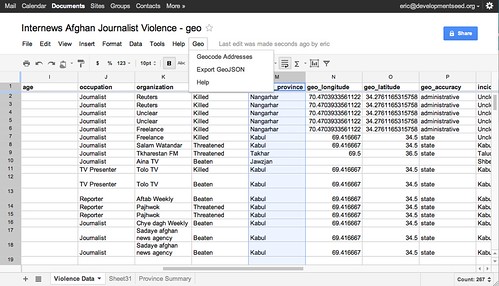Geo for Google Sheets is a tool that allows you to geocode places and addresses in Google Sheets. By geocoding, you provide your sheet with an extra set of fields, in which the latitude, longitude, the place type and the place identifier are stored. Geo for Google Sheets is forked from https://github.com/mapbox/geo-googledocs/, we owe a great deal of thanks to them for sharing their code with us.
- Geocode arbitrary addresses If your spreadsheet does not have coordinates, you can add them using a geocoding service like those provided by OpenStreetMap Nominatim. It also providides a method to supply historical place and street geocoding, through the Histograph service.
- Draw custom geometries If geocoding doesn't do the trick for you, or you want more complex geometries, there is a menu option that allows you to draw your own geometry. Pick anything from point, polyline or polygon.
- Export spreadsheet data to GeoJSON Any geocoded spreadsheet (longitude and latitude coordinates) can be exported to GeoJSON. GeoJSON is a powerful and flexible interoperability format for use in QGIS, for example.
- Copy the script source code
- Open your spreadsheet and goto
tools>script editor - Replace the content in the text box with the copied source
- Set the name of this script to
geo - Go to
file>saveand close the popup window - Go to
file>new>HTML - Copy the contents of the widget script
- Replace the contents of the new HTML file with the copied contents
- Set the name of this script to
leaflet-widget.html - Go to
file>saveand close the popup window - Refresh your spreadsheet and you will see a new menu called
Geoadded afterHelpon the menu bar
- Dave Cole [dhcole]
- Tom MacWright [tmcw]
- Rein van 't Veer [reinvantveer]
Geo for Google Docs is an add-on script for Google Docs Spreadsheets that lets you geocode arbitrary addresses and export spreadsheets as GeoJSON.
First copy the source code for the Geo for Google Docs script.
Next, open your spreadsheet in Google Docs and select Tools > Script Editor. Erase the default function myFunction() {} in the code window, and paste in the source code you copied. Name the project 'Geo', File > Save, and close the window. Refresh your spreadsheet and you will see a new Geo menu next to Help.
Now you're ready to use the Geo add-on. It has two simple features: geocode addresses and export as GeoJSON.
Say you've got a spreadsheet with a column for addresses. It could be a street address, a ZIP Code, a county or a state name - even a country code. To map this you need to find the geocodes, or longitude and latitude coordinates for these addresses. For locations that are more general, like "Canada", geocoding APIs usually return the coordinates of the centroid - the area's center point - or capital.
After you've installed the Geo script in your spreadsheet, you can use the Nominatim or other services to get geocodes for your addresses. First select the cells with your address data. This could be one column or several. If you select multiple columns (such as 'Address', 'City', 'State') the columns with be joined together from left to right and sent to the geocoding service. You can also select just a few cells to geocode instead of a whole column. This is useful when you add new rows or update existing addresses and only want to geocode the new data.
Once you've selected your address data, go to Geo > Geocode Addresses. If this is the first time you're using the script, you'll need to authorize it to access your spreadsheet and then go to Geocode Addresses again. Now all you need to do is set your preferred API and click Geocode.
You should now see four new columns added to your spreadsheet and coordinate data being entered into those. The third column is a response back from the geocoding service about the resolution of the geocode - something like 'residential' for street address, 'administrative' for state level match if your using Nominatim. This is particularly useful for checking the accuracy of your geocodes. For instance if you submit a country name and get back a 'residential' response, its likely that the geocoder could not figure out what to do with that address and that you should try to make it more specific, perhaps by using a three-digit code like 'USA' instead of 'United States'. If you find your geocodes are still inaccurate or slightly off, you can manually enter coordinates. Try using a service like Get Lat Lon.
Many web services exist for geocoding addresses. We use Nominatum search most often, as it is based on Open Street Map data and does not have a defined rate limit. We tend to avoid geocoders with expensive licensing. Before using any geocoder, make sure to review its terms of service. If you'd like to add a new geocoder to this script, please fork it on GitHub and submit a pull request. General issues should be reported on GitHub as well.
Now that your spreadsheet has geospatial data (coordinates), it's ready to be mapped.
To load your spreadsheet data into spatial applications like QGIS or TileMill, save the data as a GeoJSON file. To do this with the Geo script, select all the data you want to export and go to Geo > Export GeoJSON. Select a column with unique content for each row, and specify the columns with your coordinates. Then click export and download the file. You'll need to add .geojson to the end of the filename so that applications recognize it as GeoJSON.
To use this in TileMill, copy the file to your Mapbox data directory. Then open TileMill, add a new layer, and specify this file. Now you're ready to start designing your map. For more on that, see the TileMill Manual and Support Forum.
